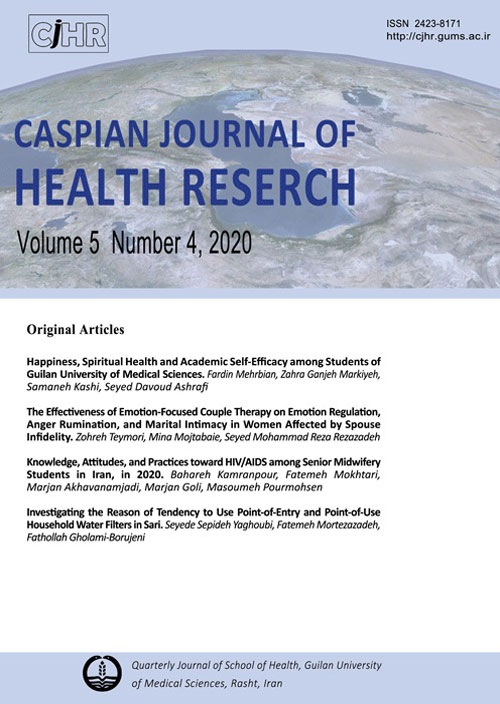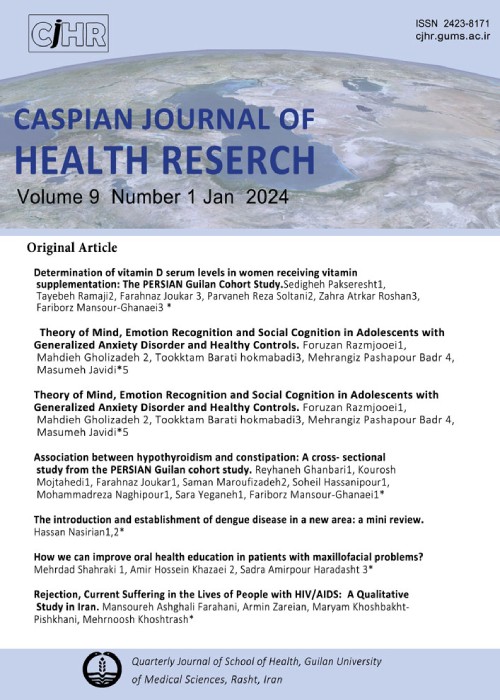فهرست مطالب

Caspian Journal of Health Research
Volume:6 Issue: 2, Jun 2021
- تاریخ انتشار: 1400/05/31
- تعداد عناوین: 4
-
-
Pages 37-46Background
Although COVID-19 has been a global crisis, respecting no boundaries, the burden and number of cases have been much lower in numerous African countries than initially feared. The reason for considerable cross-country variability across the continent remains undiscovered. Accordingly, the present study investigated the potential country-level factors associated with the COVID-19 burden in Africa .
Materials & MethodsGuided by emerging empirical findings, the rapidly evolving literature, and relevant theoretical frameworks, a unique cross-sectional dataset comprising 54 African countries were constructed. Descriptive statistics, correlation analyses, and multiple regression analyses were conducted to examine critical factors associated with COVID-19 deaths in Africa.
ResultsThe obtained data suggested that population density was negatively and significantly associated with COVID-19-induced deaths; however, the median age presented a positive, and significant association with COVID-19-related deaths. Other explored factors, such as Gross Domestic Product (GDP) per capita, global connectivity, DTP immunization coverage, the percentage of seats in parliament held by women, and political regime type demonstrated no significant relationship with COVID-19-related deaths.
ConclusionThe global empirical analyses have indicated that an array of socio-economic, demographic, political, and health-related factors may be associated with COVID-19 burden; however, the present study indicated that population density and median age were associated with COVID-19-induced deaths in Africa.
Keywords: Africa, Coronavirus, Coronavirus Disease 2019 (COVID-19), Health, Pandemic -
Pages 47-56Background
Resilience, as a variable affecting couples’ relationships and resolving conflicts between them, plays an essential role in family psychology and family therapy.
Materials & MethodsThis was a quasi-experimental study with a pre-test, post-test, a control group, and a 45-day follow-up design. The statistical population included all couples with low marital adjustment who were referred to the psychological counseling centers of Ahvaz City, Iran, in 2020. Thirty participants were selected using the convenience sampling method and randomly divided into the experimental and control groups (n=15 couples/group). The necessary data were collected using the Symptom Checklist-90-Revised (SCL-90-R), the Cognitive Avoidance Questionnaire (CAQ), and the Connor-Davidson Resilience Scale (CD-RISC). The schema therapy program was performed for the experimental group in eight 90-minute weekly sessions; however, the control group received no intervention. The follow-up phase was performed after 45 days. Repeated-Measures Analysis of Variance (ANOVA) was used in SPSS to analyze the obtained data.
ResultsSchema therapy effectively decreased anxiety and cognitive avoidance and increased resilience among couples in the experimental group (P<0.001). The Mean±SD post-test score of resilience was measured as 50.87±4.64 in the experimental group, which increased, compared to the post-test scores (43.33±5.71) in the control group.
ConclusionSchema therapy decreased anxiety, cognitive avoidance, and significantly increased resilience in the examined couples. Schema therapy can be used to improve resilience in couples presenting marital conflicts.
Keywords: Schema therapy, Anxiety, Cognitive avoidance, Resilience -
Pages 57-64Background
The present project presented the prevalence of pediculosis in Behbahan County, Iran, to plan effective control programs in this area.
Materials & MethodsThe data of head lice were collected from the Behbahan Public Healthcare centers. Accordingly, the relevant prevalence rate was estimated according to the age, gender, residential place, and season of the year.
ResultsThere were 8002 pediculosis cases reported in Behbahan County from January 2017 to December 2018. The prevalence of pediculosis was reported as 2.31% and 1.99% in 2017 and 2018, respectively. The prevalence among females (3750 per 100000 population) was significantly higher than that in males (929 per 100000 population) (P<0.001). Respecting age, the highest prevalence was among the 6-12 years age group with a prevalence of 8067 and 7285 subjects per 100000 population in 2017 and 2018, respectively. The highest number of cases were found in October.
ConclusionAccording to our collected results, the illness requires a higher degree of concentration management to adequately manage.
Keywords: Pediculosis, Behbahan, Pediculus capitis, Head lice -
Pages 65-72Background
The role of nutrition is undeniable in controlling hypertension; diet is among the most effective non-pharmaceutical methods. The current study aimed to determine the role of illness perception on diet adherence in patients with hypertension.
Materials & MethodsThis cross-sectional study examined 268 patients with hypertension. The study sample was selected by convenience sampling method. The study tool consisted of the patients’ individual, social, and clinical factors, illness perception about hypertension, and adherence to the diet. The necessary data were analyzed using multiple logistic regression models.
ResultsThe Mean±SD score of illness perception was measured as 37.09±4.91 out of 56. Adherence to the recommended diet was relatively desirable in the majority of the examined patients (62%). Multiple logistic regression analysis data revealed no significant relationship between the scores of illness perception and dietary adherence (Adjusted OR=1.038, 95%CI: 0.974-1.105, P =0.250). The main predictor of dietary adherence was having hypertension dietary knowledge (OR=2.198, 95%CI: 1.198-4.035, P=0.011).
ConclusionOur study data revealed that increasing awareness among patients with hypertension complications can improve self-care behaviors, including adherence to standard diets. Therefore, emphasis on increasing awareness among these patients and their continued follow-up seems necessary.
Keywords: Adherence, Diet, Hypertension, Perception


